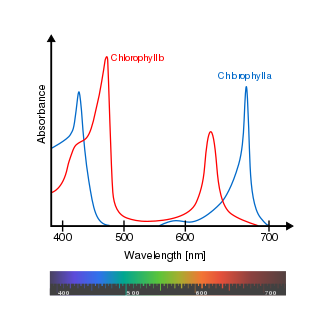Chlorophyll b




Chlorophyll b is a type of chlorophyll that is found in certain photosynthetic organisms, including plants, algae, and cyanobacteria. It serves as an accessory pigment, playing a crucial role in the process of photosynthesis by capturing light energy and transferring it to chlorophyll a, which then converts it into chemical energy. Chlorophyll b helps in broadening the range of light wavelengths that a plant can use for energy, particularly in the blue and red parts of the spectrum, which are vital for efficient photosynthesis.
Structure and Function[edit]
Chlorophyll b is chemically similar to chlorophyll a, the primary pigment involved in photosynthesis, but it has a formyl group (-CHO) instead of a methyl group (-CH3) on the second carbon of the porphyrin ring. This slight difference in structure causes chlorophyll b to absorb light at slightly different wavelengths than chlorophyll a, specifically in the blue range of the spectrum. This characteristic allows plants containing chlorophyll b to absorb light more efficiently, especially in shaded conditions or where light intensity is low.
In the thylakoid membrane of the chloroplast, chlorophyll b is found in the light-harvesting complexes associated with Photosystem I and Photosystem II. These complexes act as antennae, capturing light energy and transferring it to the reaction center chlorophyll a molecules, where the energy is used to drive the synthesis of ATP and NADPH, the energy carriers needed for the Calvin cycle and other biosynthetic processes.
Distribution[edit]
Chlorophyll b is not universally present in all photosynthetic organisms. It is predominantly found in higher plants, green algae, and euglenophytes. Its presence in these organisms contributes to their green color, alongside chlorophyll a. In contrast, other photosynthetic organisms, such as red algae and brown algae, utilize different accessory pigments and do not contain chlorophyll b.
Ecological and Evolutionary Significance[edit]
The evolution of chlorophyll b is considered a significant event in the history of life on Earth, as it allowed plants and algae to exploit a wider range of light environments. This adaptation likely contributed to the diversification and success of these organisms in various ecological niches, from deep shade under forest canopies to bright, open areas. The ability to capture more light energy and perform photosynthesis more efficiently under diverse conditions has been a key factor in the dominance of chlorophyll b-containing plants in many terrestrial ecosystems.
Synthesis and Degradation[edit]
The synthesis of chlorophyll b is tightly regulated and involves the conversion of chlorophyll a through the action of the enzyme chlorophyllide a oxygenase. The degradation of chlorophyll b, which occurs during leaf senescence and in response to stress conditions, is also a complex process that leads to the breakdown of the chlorophyll molecule and the recycling of its components.
Conclusion[edit]
Chlorophyll b plays a vital role in the photosynthetic process, enabling plants and other organisms to capture a broader spectrum of light energy. Its presence is a key factor in the ecological success and diversity of many photosynthetic organisms. Understanding the function and significance of chlorophyll b not only sheds light on the intricacies of photosynthesis but also provides insights into the evolutionary adaptations that have allowed photosynthetic life to thrive on Earth.
Ad. Transform your life with W8MD's Budget GLP-1 injections from $75


W8MD offers a medical weight loss program to lose weight in Philadelphia. Our physician-supervised medical weight loss provides:
- Weight loss injections in NYC (generic and brand names):
- Zepbound / Mounjaro, Wegovy / Ozempic, Saxenda
- Most insurances accepted or discounted self-pay rates. We will obtain insurance prior authorizations if needed.
- Generic GLP1 weight loss injections from $75 for the starting dose.
- Also offer prescription weight loss medications including Phentermine, Qsymia, Diethylpropion, Contrave etc.
NYC weight loss doctor appointmentsNYC weight loss doctor appointments
Start your NYC weight loss journey today at our NYC medical weight loss and Philadelphia medical weight loss clinics.
- Call 718-946-5500 to lose weight in NYC or for medical weight loss in Philadelphia 215-676-2334.
- Tags:NYC medical weight loss, Philadelphia lose weight Zepbound NYC, Budget GLP1 weight loss injections, Wegovy Philadelphia, Wegovy NYC, Philadelphia medical weight loss, Brookly weight loss and Wegovy NYC
|
WikiMD's Wellness Encyclopedia |
| Let Food Be Thy Medicine Medicine Thy Food - Hippocrates |
Medical Disclaimer: WikiMD is not a substitute for professional medical advice. The information on WikiMD is provided as an information resource only, may be incorrect, outdated or misleading, and is not to be used or relied on for any diagnostic or treatment purposes. Please consult your health care provider before making any healthcare decisions or for guidance about a specific medical condition. WikiMD expressly disclaims responsibility, and shall have no liability, for any damages, loss, injury, or liability whatsoever suffered as a result of your reliance on the information contained in this site. By visiting this site you agree to the foregoing terms and conditions, which may from time to time be changed or supplemented by WikiMD. If you do not agree to the foregoing terms and conditions, you should not enter or use this site. See full disclaimer.
Credits:Most images are courtesy of Wikimedia commons, and templates, categories Wikipedia, licensed under CC BY SA or similar.
Translate this page: - East Asian
中文,
日本,
한국어,
South Asian
हिन्दी,
தமிழ்,
తెలుగు,
Urdu,
ಕನ್ನಡ,
Southeast Asian
Indonesian,
Vietnamese,
Thai,
မြန်မာဘာသာ,
বাংলা
European
español,
Deutsch,
français,
Greek,
português do Brasil,
polski,
română,
русский,
Nederlands,
norsk,
svenska,
suomi,
Italian
Middle Eastern & African
عربى,
Turkish,
Persian,
Hebrew,
Afrikaans,
isiZulu,
Kiswahili,
Other
Bulgarian,
Hungarian,
Czech,
Swedish,
മലയാളം,
मराठी,
ਪੰਜਾਬੀ,
ગુજરાતી,
Portuguese,
Ukrainian